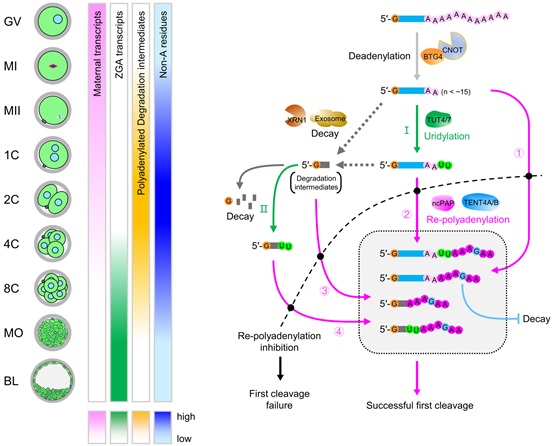The human development starts from the fertilization of a fully matured oocyte. The oocyte maturation, fertilization, and early embryo development before zygotic activation is featured by absence of new transcription from the genome. Therefore, the process of oocyte-to-embryo transition before zygotic genome activation is largely controlled by the post-transcriptional regulation of maternal RNA stored in the fully grown oocyte. However, how the maternal mRNA are post-transcriptional regulated remains elusive.
A recent study from collaboration between Prof. LU Falong at the Institute of Genetics and Developmental Biology (IGDB) of the Chinese Academy of Sciences (CAS), Prof. LIU Yusheng at the Northeast Forestry University, Prof. CHEN Zi-Jiang, Prof. ZHAO Han, Prof. WU Keliang at the Shandong University, Prof. WANG Jiaqiang at the Northeast Agricultural University, and Prof. ZHOU Bing at the Institute of Zoology of the CAS utilized PAIso-seq and PAIso-seq2 methods to comprehensively profile the poly(A) tail inclusive full-length transcriptome in human oocytes and embryos.
The study entitled “Remodeling of maternal mRNA through poly(A) tail orchestrates human oocyte-to-embryo transition” was published in Nature Structural & Molecular Biology on January16 (DOI:10.1038/s41594-022-00908-2).
In this study, the researchers found extensive poly(A) tail mediated maternal mRNA remodeling during the human oocyte-to-embryo transition. Unexpectedly, a large proportion of the maternal mRNA undergo partial degradation into their 3’-UTRs, which could be then be modified by incorporation of U residues at their 3’-ends. These transcripts do not go through degradation and can be re-polyadenylated after fertilization, contributing to the production of high level of a new type of mRNA transcripts called polyadenylated degradation intermediates.
What are the roles of these U residues incorporated and what are the roles of the polyadenylated degradation intermediates are very interesting questions to be addressed in the future. The researchers then revealed several regulators of this extensive maternal mRNA remodeling process. Importantly, the re-polyadenylation after fertilization is essential for human embryo development as evidenced by failed first embryo cleavage if the re-polyadenylation is blocked.
Poly(A) tail mediated maternal mRNA remodeling during human oocyte-to-embryo transition (Image by IGDB)
These findings provide rich resource and insight into the poly(A) tail mediated post-transcriptional regulation of maternal mRNAs in regulating the human oocyte-to-embryo transition. This mechanism will be a new angle to understand the mechanism underlying female infertility in humans. The poly(A) inclusive full-length transcriptome will likely be a potentially very useful tool in evaluating the developmental potential of the oocytes, which could be valuable for the infertility patients.?
Contact:
Dr. LU Falong
Institute of Genetics and Developmental Biology, Chinese Academy of Sciences
 Poly(A) tail mediated maternal mRNA remodeling during human oocyte-to-embryo transition (Image by IGDB)These findings provide rich resource and insight into the poly(A) tail mediated post-transcriptional regulation of maternal mRNAs in regulating the human oocyte-to-embryo transition. This mechanism will be a new angle to understand the mechanism underlying female infertility in humans. The poly(A) inclusive full-length transcriptome will likely be a potentially very useful tool in evaluating the developmental potential of the oocytes, which could be valuable for the infertility patients.?Contact:Dr. LU FalongInstitute of Genetics and Developmental Biology, Chinese Academy of SciencesEmail: fllu@genetics.ac.cn
Poly(A) tail mediated maternal mRNA remodeling during human oocyte-to-embryo transition (Image by IGDB)These findings provide rich resource and insight into the poly(A) tail mediated post-transcriptional regulation of maternal mRNAs in regulating the human oocyte-to-embryo transition. This mechanism will be a new angle to understand the mechanism underlying female infertility in humans. The poly(A) inclusive full-length transcriptome will likely be a potentially very useful tool in evaluating the developmental potential of the oocytes, which could be valuable for the infertility patients.?Contact:Dr. LU FalongInstitute of Genetics and Developmental Biology, Chinese Academy of SciencesEmail: fllu@genetics.ac.cn CAS
CAS
 中文
中文




.png)
